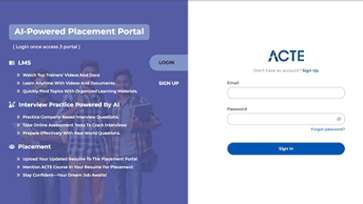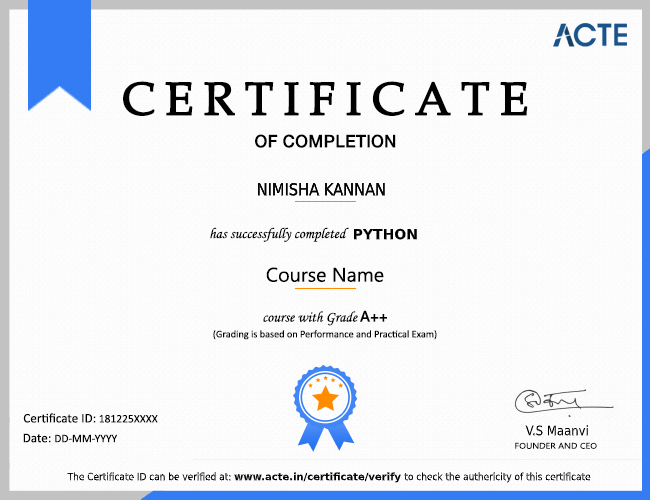ACTE offers the best Octopus Deploy online training and most industry-oriented training for the deployment of octopuses to build up your professional career. The Octopus Deploy Course program covers all principles in Octopus Deploy to get real-time expertise for automating ASP.NET application deployment management server, Windows services, simple dashboards, Octopus Deploy installation and configuration for NGINX, Octopus React BUI licenses, etc. In addition, an extensive Octopus Deploy online Course helps you obtain competence in this broad subject in order to easily fulfill your everyday obligations. The practitioners are provided by our skilled trainers so that they obtain authentic experience.
Additional Info
Intro of Octopus Deploy :
OOctopus Deploy online Course is a new technological start that provides its clients with a structured platform to facilitate complex deployments. The products offer runbook replacement for many delivery purposes that save companies time and money. Automatic deployment and uninstallation management server for use with ASP.NET applications, Windows Services, and data.
Octopus Deploy helps teams manage releases, activate, and run applications with automated runbooks. It's free for small groups. Octopus Deploy is a tool in Use as a Service section of the technical stack.
Features of Octopus Deploy :
- Serve in a place or cloud safely
- .NET, Java, PHP, Node, Ruby
- Full API support
- Approval and manual intervention
- Enable homemade use
- Installation in minutes
- It integrates with your build server
- It's free for small groups
1. The Octopus Deploy was an organization that was originally bound :
According to Techcrunch, Octopus Deploy online Course is a company that strives to establish itself as a sustainability. Things had slowed down when the company started launching. The business started in 2011 as a job for its founders in the evenings and on weekends. It didn't go away with a bang but instead it took about a decade to become such a bully today.
2. The founder is Paul Stovell :
Paul Stovell founded Octopus Deploy. He is also the chief executive officer of the company. One of his biggest challenges is getting a continuous post. In its first phase, it eventually operates the kinks and attracts a large customer base for startups.
3. Octopus Deploy initially rejected all financial support for participation :
Stoll did not comply with requests for business assistance to finance his new start. You have chosen to take the bootstrapping method to maintain full control of the operation. Although many grants were made, he turned them down for several years, even realizing that the company would benefit from bringing in an investor. It made sense for the growth rate Octopus Deploy was getting to move you forward. This Octopus Deploy online Course would not have happened without another source of funding as he has developed a long-term strategic plan that will take the company five to ten years to come.
4. Octopus Deploy is an international company :
The company was launched in Australia, where the headquarters are located. Expanded operations to include offices in Australia, the United Kingdom and the United States. It currently employs more than 100 employees. The solutions have been well received in the United States as a starting point to help grow its business market share in the region, thanks to the improvements we have made in business investment.
5. Octopus Deploy provides cloud services or facilities :
At a time when many are turning to cloud-based solutions, Octopus is designed to provide both services. The platform is configured to move applications securely to servers of both types. Used for cloud solutions and deployment. The platform has a web-based interface for conversion and posting. It provides a useful dashboard for teams to view post status, according to Everipedia.
6. Octopus Deploy is a leading automated lead tool :
According to LinkedIn, Octopus Deploy is used by 20,000 customers worldwide. It has become one of the most popular tools of its kind. The software company was named as the third number in the BRW Fast 100 for three consecutive years in operation. Some of the most notable companies using Octopus Deploy include 25 of Fortune 100, CISCO, Commonwealth Bank, NASA, and many more.
Roles and Responsibilites :
Software Engineer :
Research and analysis : While familiar with the system, most software engineers have to produce solutions without a road map. For background developers, this could mean integrating an API into their technology stack. For previous developers, this could mean building interactions that can work in most browsers. No problem, software engineers spend a lot of time researching program solutions and technical documentation for help.
System design : The end-to-end software engineer should design the technical support that brings the designer solutions to life, while the front-end engineer focuses on the user interface of the program. When researching the roles and responsibilities of a software developer, listed tasks can include tasks such as building background conclusions or creating algorithms. A software engineer always shows ingenuity in designing solutions; after all, this is what makes so many energy technologies go hand in hand, to begin with.
Implementation. : The primary purpose of a software developer is to apply the applicable code to the overall product infrastructure. Many software developers work in teams so they only focus on building specific front and back parts of a particular product. Therefore, it is important to demonstrate an understanding of the implementation protocol as an integral part of the software developer responsibilities.
Support : Products that have gone to market have never been eliminated; they are constantly in need of continuous operation, support, and installation. Software engineers regularly sponsor products they build. This means that when problems arise - such as bugs or user experience errors - the software developer must design the fix, apply the fix, and test the fix. This process is usually performed as a support and a software engineer who works closely with their QA team to continuously fund their product throughout the software development process.
Tools and FrameWorks :
Jenkins, Jira, Azure DevOps, TeamCity, and Bamboo are some of the popular tools associated with Octopus Deploy. Here is a list of all 9 tools included with Octopus Deploy.
Jekins :
Jenkins is software that allows for continuous integration. Jenkins will be installed on a server where it will be built in. Along with Jenkins, sometimes, one can also see the Hudson organization. Hudson is a Java-based Java integration tool developed by Sun Microsystems later acquired by Oracle. After the discovery of Sun by Oracle, a fork was created from the source of Hudson's source, which brought the launch of Jenkins.
Jenkins is a continuous Integrated Integrated Integrated server in Java for a series of actions to accomplish an integrated process of continuous automation. Jenkins supports the complete cycle of software life from design, testing, software writing, shipping, and other stages of the software life cycle. Jenkins is a widely used app worldwide with about 300k installations and growing day by day. By using Jenkins, software companies can speed up their software development process, as Jenkins are able to build and test faster.
A server-based application also requires a web server like Apache Tomcat. The reason why Jenkins software is so popular is because of its focus on repetitive tasks that occur during project development. For example, when your team launches a project, Jenkins will continue to check that your project builds and shows you flaws in the early stages of your development.
How does Jenkins work?
Jenkins is a server-based program and requires a web server such as Apache Tomcat to run on various platforms such as Windows, Linux, MacOS, Unix, etc. To use Jenkins, you need to create a sequence pipeline that the Jenkins server will take. The Jenkins Continuous Integration Pipeline is a powerful tool that contains a set of tools designed to handle, monitor, compile and test code, or code modification, such as :
- Ongoing Integration Server (Jenkins, Bamboo, CruiseControl, TeamCity, and others)
- Source Control Tool (e.g., CVS, SVN, GIT, Mercurial, Perforce, ClearCase and others)
- Building Tool (Make, ANT, Maven, Ivy, Gradle, others)
- Automatic testing framework (Selenium, Appium, TestComplete, UFT, and others)
Jira :
Jira is the earliest project management software, but began its life in 2002 as a tracking platform for software developers. It is now offered in three different packages :
- Jira Core - A basic Jira project management platform.
- Jira Software - Provides all Jira Core functions, but also includesadditional Agile functionality.
- Jira Service Desk - Means IT professionals or other types of service desks. This guide will ignore the Jira Service Desk because it is not compatible with project management.
What is Jira used for?
Since its inception, Jira has grown to include all types of project management. The platform covers all types of project management skills, including software development, Agile project management, bug tracking, scrum management, content management, marketing, technical services management, and much more. IRA is a software testing tool developed by the Australian Company Atlassian. A bug tracking tool that reports all issues related to your software or mobile applications. The name JIRA comes from a Japanese word, namely, "Gojira" which means Godzilla.
Aspects of Jira :
- Projects - Used to effectively manage disability.
- Problem - Used to track and manage disability / issues.
- Workflow - Processes the Issue / Error life cycle. Suppose we have a business need, we create a technological structure and from the technical development, we create experimental cases. After creating test cases, coding is done, and testing is done on the project. This flow of work is possible through Jira.
- Search - Find easily. Let’s say we did it with a project in early December and its version is 1.0. Now, we are moving to version 1.1 and it was finalized by the end of December. What we do is add new varieties. In Jira, we do not know what happened in previous versions, how many mistakes were made in previous projects and what we learn from previous projects.
- Dashboards - Dashboard is the display you see when you sign in to Jira. You can create multiple dashboards for multiple projects. You can create your own dashboard and add gadgets to the dashboard so you can keep track of assignments and issues you're working on.
Why JIRA :
The JIRA tool is used for the following reasons :
Plan, Track and Work Fast :
- JIRA is a bug tracking tool mainly used for tracking, editing, and prioritizing bugs, new features, development of specific software releases. Projects are divided into problems and issues can be of many types such as bug, new feature, upgrade tasks, and documentation.
- As the software release date approaches, software developers need to focus on the remaining issues that need to be addressed before the due date. It is also difficult for QA to keep the status of the documents, that is, sometimes it is difficult to keep track of everything.
- JIRA is a good option to address the above problems. It empowers software developers to track issues and developments. Manages projects and maintains technical records.
The Main Source of Information :
JIRA is the main source of information for the next software release. At JIRA, the entire team of software developers can plan new features and bugs to be fixed in the next release. It also helps the QA team to write technical documents. With JIRA, the QA team can review the status of each feature recently installed by software developers, and accordingly, they can plan how to write a new version.
The JIRA tool is used to organize text tasks. It helps to collect multiple tasks using segment functionality, and you can create your own text. In this way, you can create a structured approach to texts. Keep track of the progress of our publications. It is a very useful tool for tracking the progress of our publications. The JIRA tool provides the most important feature, namely, the macro pie chart. In the pie chart, you can view tasks such as open jobs, closed jobs, solved tasks. Helps to meet deadlines for publication. You can specify an appropriate date or release deadline, and you can configure the JIRA tool with notifications so you can complete your documents on time.
Measure the time spent on documents :
The JIRA tool does not have the default functionality for measuring the time spent on documents. The JIRA tool is integrated with Tempo Timesheets, which measures how much time is spent on documents. Provides immediate feedback. The JIRA tool provides Confluence pages where you can connect to problems with just a few clicks. If something needs to be updated, then you can create issues directly on the Confluence page.
Required Skills :
The prerequisites of the course require you to have a basic knowledge of :
- Any graduate or postgraduate degree
- Excellent Communication Skills
Certification :
After completing this training, you can acquire a final certificate, which shows that you have successfully completed our Octopus Deploy training. Get the certification in Octopus Deploy with the useful resource for passing the web exam with a minimum score of 70%. To prepare for the certification exam, we provide you with a simulation exam and a practice exam.
Benefits :
- It is powerful
- Easy to read
- .Net by customers
- Easy to manage extraction and retrieval
- A beautiful display
- Posting becomes very minor errors and is repeated
- Anyone in the group can download the software
- Engineers use their time to develop software
- Relocation is not a headache
- You can remove it many times
Payscale :
Software Engineer Salaries in India are between 2.0 Lakhs to 17.0 Lakhs with an annual salary of 35.3 Lakhs. Salary estimates are based on the 141.8k salary received from Software Developers.
































